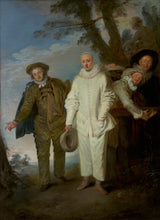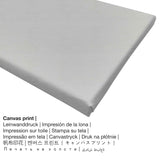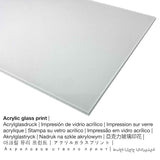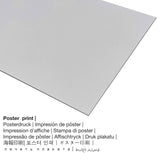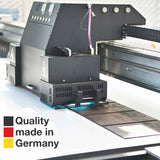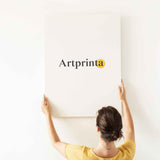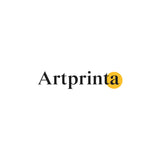Antoine Watteau, 1720 - Ndị na-akpa ọchị Italy - mbipụta nka mara mma
Ụtụ gụnyere. Mbupu gbakọrọ na ndenye ọpụpụ.
In 1720 Antoine Watteau made this painting. The artwork measures the size of 128,9 x 93,3 cm. Mmanụ na kwaaji was used by the European painter as the technique for the masterpiece. It can be viewed in in the Ụlọ ihe ngosi nka nke J. Paul Getty digital art collection. This masterpiece, which is in the public domain is being included with courtesy of Ụlọ ihe ngosi nka nke J. Paul Getty.Creditline of the artwork: . Moreover, alignment of the digital reproduction is portrait with a side ratio of 1: 1.4, which implies that the length is 29% shorter than the width. The painter Antoine Watteau was a European artist, whose artistic style was mainly Rococo. The artist was born in the year 1684 in Valenciennes and passed away at the age of 37 na 1721.
Ozi nka nka izizi sitere na J. Paul Getty Museum (© - Ụlọ ihe ngosi nka nke J. Paul Getty - Ụlọ ihe ngosi nka nke J. Paul Getty)
Five comedians have just finished their performance in a verdant park on the outskirts of Paris and look expectantly at their audience. Pierrot, the clown in a baggy white suit, is already holding his hat in his hand, hoping that a few coins might be thrown into it.
Flanking Pierrot are four other performers dressed as characters from the Italian commedia dell'arte, which enjoyed great popularity in 18th-century Paris. Brighella wears a splendid greenish-gold suit and shoulder cape trimmed with black stripes. Mezzetin strums a few chords on his guitar, while Harlequin in a black mask with its horsehair eyebrows and moustache peers over his shoulder. A mock Spanish costume of black velvet with a white ruff identifies the figure on the far right as Scaramouche.
The actors penetrate our world with an intense humanity and vivid reality, far removed from the theatrical artifice and caprice of the stage they have just left.
Ozi ndabere ihe nka
| Aha nka: | "Ndị ọchị ọchị Italy" |
| Nhazi nka: | sere |
| Otu sara mbara: | nka ochie |
| Time: | 18th narị afọ |
| Afọ nka: | 1720 |
| Afọ nka: | karịa afọ 300 |
| Usoro nka izizi: | mmanụ na kwaaji |
| Nha nke ihe nka izizi: | 128,9 x 93,3 cm |
| Ụlọ ihe ngosi nka: | Ụlọ ihe ngosi nka nke J. Paul Getty |
| Ebe ngosi nka: | Los Angeles, California, Njikota Obodo Amerika |
| website: | Ụlọ ihe ngosi nka nke J. Paul Getty |
| Ụdị nka nka: | ngalaba ọha |
| Site n'aka: | Ụlọ ihe ngosi nka nke J. Paul Getty |
Ozi nka ahaziri
| Ihe nkiri: | Antoine Watteau |
| okike nke onye nka: | nwoke |
| Obodo onye nka: | French |
| Ọrụ onye na-ese ihe: | onye na-ese ihe |
| Obodo obibi: | France |
| nhazi ọkwa: | nna ukwu ochie |
| Ụdị nka: | Rococo |
| Ndụ: | 37 afọ |
| Afọ ọmụmụ: | 1684 |
| Ebe omuma: | Valenciennes |
| Afọ ọnwụ: | 1721 |
| Obodo ọnwụ: | Nogent-sur-Marne |
Họrọ nhọrọ akụrụngwa gị
Maka mbipụta nka ọ bụla anyị na-enye ụdị nha na ihe dị iche iche. Anyị na-ahapụ gị ka ịhọrọ n'ime ụdị ndị a:
- Akwụkwọ mmado ebipụtara (akwa akwa akwa): The Artprinta poster is a UV printed canvas with a nice surface finish. It is perfectly used for placing the art print using a custom frame. Please note, that depending on the size of the poster print we add a white margin of something between 2-6cm round about the painting, which facilitates the framing.
- Mbipụta kanvas: A UV printed canvas stretched on a wood stretcher frame. It has the plastic look of three-dimensionality. A printed canvas generates a homelike, pleasing impression. How can I hang a canvas print on the wall? Canvas Prints have the advantage of being relatively low in weight. This means, it is quite simple to hang up the Canvas print without the support of additional wall-mounts. Canvas prints are suitable for any kind of wall.
- Mbipụta iko acrylic na-egbuke egbuke: The print on acrylic glass, often denoted as a print on plexiglass, will convert your favorite original work of art into amazing home décor. The work of art will be custom-made with state-of-the-art UV direct print technology. It makes vivid and sharp colors. With an acrylic glass fine art print contrasts as well as small color details become more identifiable with the help of the fine tonal gradation of the print. The acrylic glass protects your chosen art print against light and heat for many years.
- Metal (aluminium debond mbipụta): An Aluminium Dibond print is a print with an outstanding depth. For the Aluminium Dibond option, we print the chosen work of art on the aluminium white-primed surface. This direct print on aluminium is one of the most popular entry-level products and is an extremely stylish way to showcase art prints, as it draws focus on the replica of the artwork.
Ngwaahịa a
| Ụdị ngwaahịa: | nka nka |
| Usoro mmeghari: | dijitalụ mmeputakwa |
| Usoro mmepụta: | Mbipụta UV ozugbo (mbipụta dijitalụ) |
| Nlụpụta: | German mere |
| Stockdị ngwaahịa: | na mmepụta ihe |
| Ojiji ngwaahịa: | foto mgbidi, ụlọ mmepụta nka nka |
| Ndozi onyonyo: | nhazi ihe osise |
| Njikwa oyiyi: | 1: 1.4 |
| Akụkụ akụkụ pụtara: | ogologo bụ 29% mkpụmkpụ karịa obosara |
| Akụrụngwa dị: | Mbipụta iko acrylic (nwere ezigbo mkpuchi iko), mbipụta ọla (aluminium dibond), mbipụta akwa akwa, mbipụta akwụkwọ mmado (akwụkwọ kwaaji) |
| Nhọrọ nha nke akwa akwa n'elu etiti ihe na-agbatị (mbipụta kwaaji): | 50x70cm - 20x28", 100x140cm - 39x55" |
| Acrylic glass print (nwere ezigbo mkpuchi iko) nhọrọ: | 50x70cm - 20x28", 100x140cm - 39x55" |
| Nhọrọ nke mbipụta akwụkwọ mmado (akwụkwọ kwaaji): | 50x70cm - 20x28" |
| Nhọrọ nha mbipụta aluminium dibond: | 50x70cm - 20x28", 100x140cm - 39x55" |
| Nhazi nke nka nka: | biko buru n'uche na edeghi akwukwo nka nka |
Nkwupụta iwu: We try our best to describe our products in as much detail as possible and to display them visually on the respective product detail pages. Please keep in mind that the colors of the print materials, as well as the imprint can diverge marginally from the presentation on the screen. Depending on the settings of your screen and the quality of the surface, color pigments can unfortunately not be printed 100% realistically. Because our fine art prints are printed and processed by hand, there may as well be minor deviations in the exact position and the size of the motif.
© Copyright - www.artprinta.com (Artprinta)

